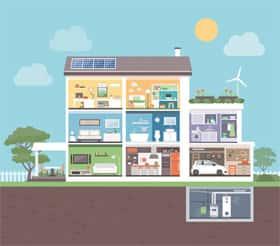 The fires that ripped through Sonoma County during the October 2017 firestorm provided a raw look at the cost we pay for the energy we need to power our lives. Regardless of whether it was the high voltage electric lines that started the fires and melted natural gas lines fanning the flames, propane tanks were seen and heard bursting into flames from miles away. Clearly, it’s obvious now that the energy-heavy or combustion-centric life we lead, has dangerous pitfalls.
The fires that ripped through Sonoma County during the October 2017 firestorm provided a raw look at the cost we pay for the energy we need to power our lives. Regardless of whether it was the high voltage electric lines that started the fires and melted natural gas lines fanning the flames, propane tanks were seen and heard bursting into flames from miles away. Clearly, it’s obvious now that the energy-heavy or combustion-centric life we lead, has dangerous pitfalls.
When reconstructing a home lost in the wildfire, homeowners will have an opportunity to embrace many new technologies. Rebuilds will be required to adhere to current building codes and a higher energy-efficiency standard will be applied as well.
You can be sure that LED lighting, thicker insulation, and tight heating ducts will provide for a more comfortable home, but little thought is being given to the fuels that heat and powers our homes and devices. Fuel costs are always increasing, and the delivery method for this fuel has proven to be dangerous.
So why are so many homes being designed to keep its inhabitants in a position to have to buy fuel forever? Why aren’t these new homes being equipped with resource-saving equipment? For the most part, it’s lack of education on behalf of the homeowner, home builder, and architect.
Mention the term “all-electric house,” and for many people it brings to mind burnt eggs from an electric stove coil with no temperature control, or an ugly electric baseboard heater with limited control over the range of heat and just enough to make you uncomfortable. Then there’s that old electric tank water heater sitting in the basement, eating up hundreds of dollars per month to keep water warm while nobody is home. It’s no wonder the idea of an all-electric home is unappealing.
Many people who are rebuilding believe they can’t afford to build a sustainable home, especially one that includes an off-grid battery system purported to be too cumbersome and unreliable for everyday life. But with a little knowledge, the decision to make a home a more self-sufficient one becomes more comfortable, especially when you’re starting over.
Here are four simple design changes you can incorporate into any home to make them more adaptable to accept new technology when the time is right.
Main Electric Service Panel. PG&E has stated that every house in Coffey Park will be receiving a 200-amp service when rebuilt. This is a big upgrade for many houses because originally a 100-amp service was standard. However, installing a 200-amp service with a 200-amp main panel can leave a home short on electrical distribution. The solution: install a “Solar Ready Main” in the 200-amp configuration, which allows 70 amps of solar power rather than the standard 40. The good news: the upgrade cost of a solar ready main panel over a standard service panel is less than $300.
Roof Design. When many homes were originally designed, rooftop solar wasn’t as cost-effective as it is today. Moreover, fire departments didn’t have the safety rules they have today governing setbacks, walkways and where panels could be installed on a roof. Planning a rebuild to maximize your home’s solar potential is smart. The best roofs for solar are usually south-facing roofs. However, roofs facing South, West or East may also be good options. On these roofs, penetrations in the middle of the roof eat up valuable energy-producing real estate. Ask your contractor to keep plumbing vents, fan outlets, and skylights in the top three feet of your roof, near the ridge, or on the sides of a given roof plane. This will leave plenty of open space for solar panels at a later time.
HVAC System. A gas-fired furnace is a cost-effective and familiar item to install. However, an electric heat pump forced air system will operate as efficiently as a gas unit. No one has an on-site natural gas plant, so this will require buying fuel from the utility forever. The distribution of natural gas can be dangerous, and the combustion is bad for the environment.
Water Heater. Another easy fuel switch is an electric heat pump water heater. These can be installed inside or out and require no venting since they aren’t combustion devices. Sonoma Clean Power (SCP) is offering incentives to homeowners taking the path to sustainability. In fact, the SCP is offering up to $12,500 in rebates. With incentives like this as well as other available money-saving options such as tax credits and municipal rebates, the cost of these high-efficiency measures are significantly reduced, or even eliminated. A properly solar-powered home employing these measures should have an annual energy bill under $200. For more information, visit sonomacleanpower.org.
Nate Gulbransen is the president of Westcoast Solar Energy, a full service independent solar and energy integrator based in Sonoma County. For additional information, go to www.westcoastsolarenergy.com. Or, you can contact Gulbransen at (707) 664-6450.




